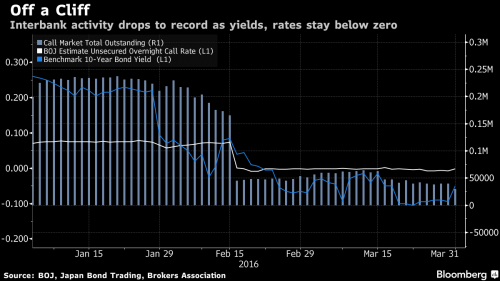Back in the summer of 2014, when the ECB first unveiled NIRP, many were concerned that this submersion into the monetary policy twilight zone would first crush Europe’s money markets. However, at least until now, European MM funds have proven relatively resilient,
The story in Japan is different.
When the Bank of Japan announced they were instituting NIRP back in January, they intended to spur lending and push inflation up. As often is the case with central planners, their academic theory was much different than the economic reality.
Money market has fallen off a cliff in Japan, and the freeze in short-term credit markets can be solely attributed to the BOJ’s negative interest rate policy. So far, in a contrast to the financial crisis, activity is frozen simply because brokers are having a hard time pricing and processing transactions as opposed to concern over counterparty risk (for now). Firms have capital to sustain this short-term freeze at the moment, but the break in this market is certainly something to keep a close eye on.
This sums up the sentiment in Japan: “Among central banks, the BOJ is the one that destroys functioning markets the most,” Izuru Kato, the president of Totan Research in Tokyo was quoted by Bloomberg.
“Companies will slash staff and scale back operations where activity is grinding to a halt, exposing markets to spikes in rates when the time comes for normalization.”
What normalization?
As quoted by Bloomberg.shows, the interbank call market hit a record low at the end of March.

As the BOJ continues to push on the NIRP string, the list of unintended consequences grows by the minute. Outside of the short term credit freeze and complete inability to set borrowing costs, there are more concerns starting to bubble up. Banks may be preparing to lay off workers due to the lull in transactions, which won’t help their wage and inflation issues. Traders are simply trying to front run BOJ asset purchases as a way to earn profits, as the rest of the “market” is eroding – which is spilling over to banks of course, as their inability to make money lending forces them to turn to a buy & sell to the BOJ model for profits.









Leave A Comment